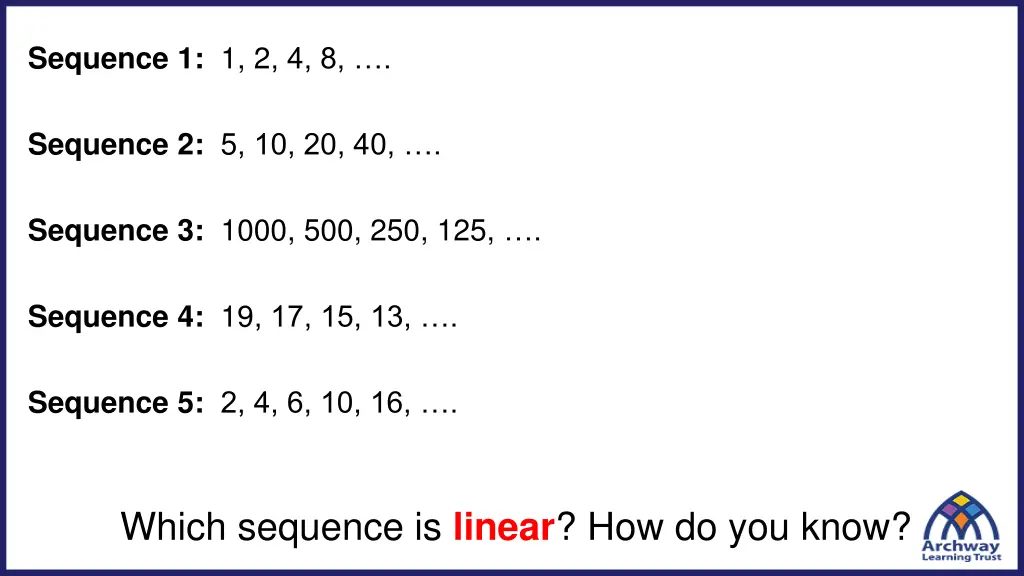
Understanding Different Types of Sequences in Mathematics
Explore linear, Fibonacci-like, and geometric sequences in mathematics through examples and explanations. Learn how to identify and describe each type of sequence with clear visuals. Dive deep into arithmetic, Fibonacci, geometric, and other sequence types.
Download Presentation

Please find below an Image/Link to download the presentation.
The content on the website is provided AS IS for your information and personal use only. It may not be sold, licensed, or shared on other websites without obtaining consent from the author. If you encounter any issues during the download, it is possible that the publisher has removed the file from their server.
You are allowed to download the files provided on this website for personal or commercial use, subject to the condition that they are used lawfully. All files are the property of their respective owners.
The content on the website is provided AS IS for your information and personal use only. It may not be sold, licensed, or shared on other websites without obtaining consent from the author.
E N D
Presentation Transcript
Sequence 1: 1, 2, 4, 8, . Sequence 2: 5, 10, 20, 40, . Sequence 3: 1000, 500, 250, 125, . Sequence 4: 19, 17, 15, 13, . Sequence 5: 2, 4, 6, 10, 16, . Which sequence is linear? How do you know?
Sequence 4: 19, 17, 15, 13, . This is a linear sequence because it decreases by a constant difference. Linear sequences are sometimes known as Arithmetic sequences.
Sequence 1: 1, 2, 4, 8, . Sequence 2: 5, 10, 20, 40, . Sequence 3: 1000, 500, 250, 125, . Sequence 4: 19, 17, 15, 13, . Sequence 5: 2, 4, 6, 10, 16, . Which sequence is Fibonacci-like? How do you know?
Sequence 5: 2, 4, 6, 10, 16, . This sequence is a Fibonacci sequence as the next term is the sum of the two previous terms.
Sequence 1: 1, 2, 4, 8, . Sequence 2: 5, 10, 20, 40, . Sequence 3: 1000, 500, 250, 125, . What do these sequences have in common?
Sequence 1: 1, 2, 4, 8, . Sequence 2: 5, 10, 20, 40, . Sequence 3: 1000, 500, 250, 125, . The next number is found by multiplying or dividing the previous term by a fixed, non- zero number. These sequences are called Geometric sequences.
Student A Types of Sequences Tick or Trash Student B Arithmetic 3, 7, 11, 15, 19, 23, Geometric Fibonacci Square Numbers 1, 4, 9, 16, 25, 36, Arithmetic Geometric 3, 6, 12, 24, 48, Fibonacci Triangle Numbers 1, 1, 2, 3, 5, 8, 13 Fibonacci -2, 4, -8, 16, -32, Geometric Geometric Cubed Numbers 1, 8, 27, 64, 125
Sequence 1: 1, 2, 4, 8, . Sequence 2: 5, 10, 20, 40, . Sequence 3: 1000, 500, 250, 125, . Sequence 4: 19, 17, 15, 13, . Sequence 5: 2, 4, 6, 10, 16, . Describe how to go from one term to the next term of each sequence
Sequence 1: 1, 2, 4, 8, . Multiply the previous term by 2, starting with 1 Sequence 2: 5, 10, 20, 40, . Multiply the previous term by 2, starting with 5 Sequence 3: 1000, 500, 250, 125, . Half the previous term, starting with 1000 Sequence 4: 19, 17, 15, 13, . Subtract 2 from the previous term starting with 19 Sequence 5: 2, 4, 6, 10, 16, . Add together the two previous terms, starting with 2 and 4 as the first two terms This rules are known the term to term rules
In your book Title: Non - Linear Sequences Q2. Describe in words the term to term rule for each sequence from Q1 Q1. Find the next two terms in each sequence a) 1, 2, 4, 8 b) 3, 6, 12, 24 c) 640, 320, 160 d) 1, 3, 6, 10 e) 1, 4, 9, 16, 25 f) 1, 1, 2, 3, 5 g) 100, 150, 225 h) 2, 2, 4, 6, 10 i) 1, 2
Mark and correct your work Q2. Describe in words the term to term rule for each sequence from Q1 Q1. Find the next two terms in each sequence a) 1, 2, 4, 8, 16, 32 b) 3, 6, 12, 24, 48, 96 c) 640, 320, 160, 80, 40 d) 1, 3, 6, 10, 15, 21 e) 1, 4, 9, 16, 25, 36, 49 f) 1, 1, 2, 3, 5, 8, 13 g) 100, 150, 225, 325, 450 h) 2, 2, 4, 6, 10, 16, 26 i) 1, 2 (lots of different answers!) a) Multiply by 2 b) Multiply by 2 c) Divide by 2 d) Add one more each time e) Add two to the first difference each time f) Add the two previous terms g) Add 25 to the first difference h) Add the two previous terms
